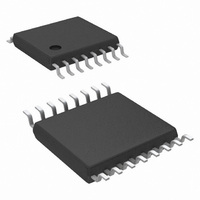LM5575QMH/NOPB National Semiconductor, LM5575QMH/NOPB Datasheet - Page 16

LM5575QMH/NOPB
Manufacturer Part Number
LM5575QMH/NOPB
Description
IC BUCK SYNC ADJ 1.5A 16TSSOP
Manufacturer
National Semiconductor
Series
PowerWise®, SIMPLE SWITCHER®r
Type
Step-Down (Buck)r
Datasheet
1.LM5575MHNOPB.pdf
(22 pages)
Specifications of LM5575QMH/NOPB
Internal Switch(s)
Yes
Synchronous Rectifier
No
Number Of Outputs
1
Voltage - Output
1.23 ~ 70 V
Current - Output
1.5A
Frequency - Switching
200kHz, 485kHz
Voltage - Input
6 ~ 75 V
Operating Temperature
-40°C ~ 125°C
Mounting Type
Surface Mount
Package / Case
16-TSSOP Exposed Pad, 16-eTSSOP, 16-HTSSOP
Power - Output
2.1W
Lead Free Status / RoHS Status
Lead free / RoHS Compliant
Other names
LM5575QMH
www.national.com
(2
pole leaving a single pole response at the crossover frequen-
cy of the loop gain. A single pole response at the crossover
frequency yields a very stable loop with 90 degrees of phase
margin.
For the design example, a target loop bandwidth (crossover
frequency) of 15kHz was selected. The compensation net-
work zero (f
tude less than the target crossover frequency. This constrains
the product of R4 and C5 for a desired compensation network
zero 1 / (2
proportionally decreasing C5, increases the error amp gain.
Conversely, decreasing R4 while proportionally increasing
C5, decreases the error amp gain. For the design example
C5 was selected for 0.01µF and R4 was selected for
49.9kΩ. These values configure the compensation network
zero at 320Hz. The error amp gain at frequencies greater than
f
The overall loop can be predicted as the sum (in dB) of the
modulator gain and the error amp gain.
Z
π
is: R4 / R5, which is approximately 10 (20dB).
R4C5). The error amplifier zero cancels the modulator
FIGURE 10. Error Amplifier Gain and Phase
π
Z
R4 C5) to be less than 2kHz. Increasing R4, while
) should be selected at least an order of magni-
20208816
16
If a network analyzer is available, the modulator gain can be
measured and the error amplifier gain can be configured for
the desired loop transfer function. If a network analyzer is not
available, the error amplifier compensation components can
be designed with the guidelines given. Step load transient
tests can be performed to verify acceptable performance. The
step load goal is minimum overshoot with a damped re-
sponse. C6 can be added to the compensation network to
decrease noise susceptibility of the error amplifier. The value
of C6 must be sufficiently small since the addition of this ca-
pacitor adds a pole in the error amplifier transfer function. This
pole must be well beyond the loop crossover frequency. A
good approximation of the location of the pole added by C6
is: f
BIAS POWER DISSIPATION REDUCTION
Buck regulators operating with high input voltage can dissi-
pate an appreciable amount of power for the bias of the IC.
The V
nominal V
V
the Vcc regulator. There are several techniques that can sig-
nificantly reduce this bias regulator power dissipation. Figure
12 and Figure 13 depict two methods to bias the IC from the
output voltage. In each case the internal Vcc regulator is used
to initially bias the VCC pin. After the output voltage is estab-
lished, the VCC pin potential is raised above the nominal 7V
regulation level, which effectively disables the internal V
regulator. The voltage applied to the VCC pin should never
exceed 14V. The V
V
CC
IN
p2
voltage.
regulator translates into a large power dissipation within
= fz x C5 / C6.
CC
FIGURE 11. Overall Loop Gain and Phase
regulator must step-down the input voltage V
CC
level of 7V. The large voltage drop across the
CC
voltage should never be larger than the
20208817
IN
to a
CC










